By their necks you will know them (english version)
By Jan Markus Adams
“The philosopher looks like a cartoon character!”, laughed my team mate Dieter to our coach Matthias. “That big body and then such a tiny neck.”
When he said this I was in Martial Arts for fifteen years and I did strength training for seven years, but my neck muscles weren’t much impressed of this. Instead, I was proud of my slim neck. At Judo our neck training was lying on our backs while holding our heads in the air for a while. At Karate we pressed our heads in the palm of our hands in all four directions for twenty seconds. So I worked nearly my whole body for years with special strength and toughening exercises (in winter I wasn’t ably to move my fingers because of my swollen knuckles) but my neck was treated like falling to pieces when touched.
One year before Dieters comment I had read the autobiography of the english wrestler Sir Atholl Oakley ‘Blue Blood on the Mat. The All-In Wrestling Story’. He made it as the first Britisher, earning a reputation in the USA for being a heavy weight wrestler in spite of undernourishment after WWI. By hard work he built up to 100kgs crowned by 50cm neck circumference. On his way he met many fascinating characters, such as the lithuanian wrestler Karl Pojello ‘The intellectual on the mat’.
Karl Pojello: „He just weightlifter. Mr. Sherry no beat Mr. Pojello like that. All wrestlers beat weightlifters. Barbellers have veak necks. Atol, you beat Samson, strongest man in vorld, mit neck lock I tink. You know what I say true.“
(aus: Sir Atholl Oakely: Blue Blood on the Mat. The All-In Wrestling Story. Summersdale 1996.)
By reading this book I was dying to learn more about the secrets of wrestling. Besides I learned the theory about the importance of neck training. When I started Grappling and Submission Wrestling I got to know soon and painful the practical advantages.
My first fight against an experienced grappler was a revelation. Weighing 20kgs more than my opponent, in martial arts for fourteen years and feeling as strong as a bear I tapped like a telegraph. Then we started sparring with each other two times a week for a year. In the night after training I couldn’t sleep because my whole body was aching. The regeneration held on until we had our next session. He showed me what it means to fight and he showed me the basics of neck training (Cheers Einstein!) After this year I became member in his club too. Then the whole trouble started again (Cheers Suum Cuique!).
Through grappling opened up a whole new world for me. I could use what I already knew und start the real voyage. At first I tried the exercises my teammates showed to me, the neckharness, neckcrunches and lying head turns. This strengthend my neck but it didn’t grow much.
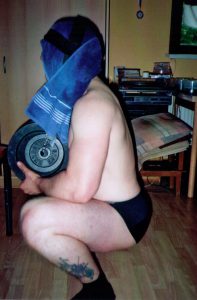
So I did the only thing, you can do, if you want to achieve something- I started thinking on my own! I learned about the structure of the neck muscles und worked out or varied exercises in a way they seemed more effective to me. The neckharness was not longer practiced sitting, but in a deep squat. So my spine was erect and the direction of movement was more like a wrestling situation. As well I used rubber bands and moved in all directions against their resistence while lying on a bench. I did this for a few years until the bands had torn a couple of times and smashed against my head. Now I hold some distance to this kind of equiment. The wrestler bridge I used too, but thought of it more like gymnastics, inspite of the 20kgs weight I was holding on my chest while doing it.
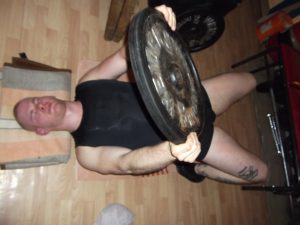
My enthusiasm for the 50cm neck of Mr.Oakely hadn’t been slowed down. Instead, it still grew through the difficulties I had to force. Finally I got Steve Helmickis ‘The Art of the Neck. Training for Distortion.’. It was quite fun reading and still is a flower in my library but it had helped more to motivate than to increase the size of my neck.
When I had to quit using my arms in training for a while because the sinew of my biceps was inflammed I got full speed ahead in working out my neck. I prefered exercises where I lifted weights with my neck. I did deadlifts with the neckharness. At full range of motion I lifted 45kgs, while doing partials I pulled 85kgs off the ground. For my sternocleidomastoideus I turned the harness around and had 100kgs swinging between my legs. Then I walked around or swung the weights front and back like a pendulum. In this way I practiced 45 minutes six times a week. By this my neck increased to 45 cm and my back was full of bloody scratchings from the chain holding the weights. No pain, no gain.
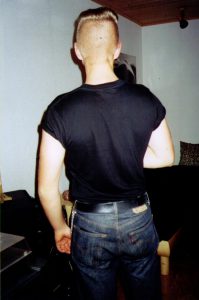
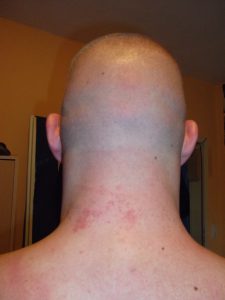
In those days I started to experiment with teeth lifts, lifting a wheight held by your teeth. Especially for full-contact fighters it makes sense, because a strong jaw is harder to break and the head is held up well, what makes it more difficult getting knocked-out. My equiment was a mortar bucket filled with 20kgs of pebbles and being possible to stack up with weights additionally. I felt comfortable with 40kgs completely. Around the grip I wrapped an old towel to bite. The hands on my knees, I lend forward and swung the bucket front and back and left and right. I must have looked like a dog playing with his prey. Great training, but great atrition, because the towels were bit to pieces really fast.
Inspired by the four-times olympic victor at wrestling and pankration, Milos of Crotos, who is supposed to have carried a calf around the stadium daily until it had grown up to a bull, I worked out with living weights. So my friends had to grab my neck or head in different ways in order to being lifted, held or lowered down. Very efficient, but you are dependent on adequate partners.
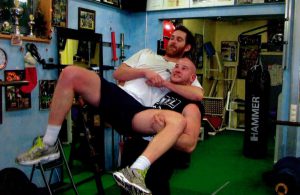
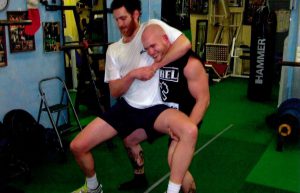
To save time I integrated the neckharness and neckcrunches in every day life. This time I used very low weights and did many reps. For neckcrunches I made a beautiful crown with weight band for the wrists. When the safety pins held it was an effective and becoming apparatus for me and a funny one for people watching me work out. Usually I did a few sets of 50 reps in the morning, noon and evening . Besides I couldn’t get rid of the wrestler bridge. Its reputation was still bewitching. But much use of it was less.
So, thinking again. The problem was, that I supposed to have bad genes. I recognised myself as a neck-hardgainer or a hardly neck gainer (a joke not working in german, so especially for you and not existing in the original text). If I skipped one workout, my neck started shrinking. I had to train daily to prevent this, so the workout had to be short. Besides wanting a thick neck, I needed a strong one, too, to fight chokes and triangles when grappling.
I thought to myself, wrestlers have the same needs as I, and many of them can fill them. I quit lifting working my neck with weights and focused on practicing the wrestler bridge, the headstand and their variations and combinations. The difference to the past was increasing the volume drastically. Earlier I hadn’t got into it because the weights were to important to me and I don’t have an infinte amount of time. And I was stil fascinated by the impression of building up a big neck without weights since the first lecture of ‘Blue Blood on the Mat’.
“ Pojello would not allow me to swim or work with weights. He considered weightlifting (or rather, exercises with heavy weights) only to be necessary for young people who wanted to build their bodies. (Atol; chain no stronger than weak link- mat game only sport which build strong neck.)“
(aus: Sir Atholl Oakely: Blue Blood on the Mat. The All-In Wrestling Story. Summersdale 1996.)
Now a great advantage revealed: this kind of exercise works the whole body. For the wrestler bridge I need the complete chain of back muscles from head to toe while stretching my rib cage and contracting my spine; but the skin on my head is torn off, what looks like a terrible epidermic disease. Some explain their loss of hair with practicing the wrestler bridge. The front-bridge uses the chain of front muscles, while extending the spine. The headstand builds up the core muscles and at Yoga they say that you can clean your lungs with it combining the right respiration. Through this cognition I was ready to go into it and invest more time with this exercises (like pull-ups are much cooler as concentration curls if you want to build up your biceps).
My routine looked like this:
- Wrestler Bridge/ Front Bridge: 2 sets, 50 reps.
- Headstand, Feet against wall, roling with nose to the floor, 2 sets, 50 reps.
- Supersets: Wrestler Bridge, Feet 50cm increased, rolling from lying position wiht nose to the floor and Headstand, like above.; 5 sets, 50 reps.
- Supersets: Lateral Wrestler Bridge, rolling from lying position to the side of the head Headstand with turning to the sides, rolling with eyes on the floor; 3 sets, 30 reps.
- Wrestler Bridge isometric, hold for 3 minutes
- Push Head against wall different ankles, 2 minutes
- Isometric Hold with Powerlifting Rubber Bands, hold with chin, push with forehead, push with the sides of head, 2 minutes
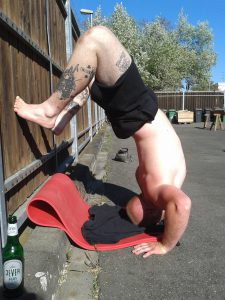
Now my necktraining was about 45 minutes again for five to six days per week. My neck grew and I got control about the muscles, enabling me resisting a choke until my opponent gets tired then free myself and turn the tide. Working out this way was quite fun, the exercises were smashing and increased my atheltic ability. Since then I wasn’t in the mood for lifting weights anymore. I had become my own weight and my neck was strong enough to hold and move my 110kgs.
Then the time got a problem again. I had to change the routine in order to shorten it. So I had to rise the intensity. Gladly, I knew about the Four-way-neck-machine and Farmer Burns. The first one, because I could do all four movements in the headstand. This saves time because it combines my first exercises and the blood flows to the head, what helps the muscles grow. By pressing my hands to the floor my deltas and traps are worked, too. More pain, more gain. The wrestler Karl Gotch, in Japan knwon as ‘The God of Wrestling’, still used to train like this when he was in his sixties.
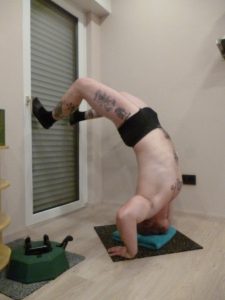
Farmer Burns helped me, as I was able to get into his main exercise. Someone who cultivates a 50cm neck at 75kgs enabling him to jump off a gallow and whistling ‘Yankee Doodle’ still hanging there, should know what he is talking about when it comes to necktraining. His exercise goes like this: put your forehead on the floor when kneeling and roll with your nose to the floor and your chin to chest. While doing this you can turn your head in various directions. By doing this you can build up neuromuscular coordination and you regulate engaging the muscles as you want. When you change the distance of knees and head you can increase or decrease the resistence your neck muscles have to stand. This makes it easy for beginners and saves the time for warming up.
My current routine:
Mein aktuelles Programm:
- Burns Front Bridge, nose to floor, chin to chest, 80 reps
- Wrestler Bridge, just push the back off the floor, 50 reps
- Burns Front Bridge, roll and turn in different directions and ankles, 150 reps
- Four-Way-Neck-System, nose to floor, chin to chest, left and reight: 3 sets, 80 reps.
- Wrestler Bridge, just push the back off the floor, 50 reps.
- Burns Front Bridge, roll and turn in different directions and ankles, 150 reps.
- Wrestler Bridge, just push the back off the floor, 50 reps.
- Burns Front Bridge, nose to floor, chin to chest, 80 reps
- Wrestler Bridge, just push the back off the floor, 50 reps.
- Wrestler Bridge, hold for 3 minutes
It takes 25 minutes. Driving a car, riding a bike or working with heavy machinery should be avoided after. The value of this training is not in a strong neck alone. As mentioned before, the whole ogranism is strengthtend. Especially the hips are involved all the time and combine the upper body with the lower body. This qualifies you to lift heavy stones at building site your coworkers need an excarvator to move. Or to pull 160kgs at deadlifting after a long day, without warming up and after quitting to use this exercise two years ago.
„I wish to impress upon all my students the great value of physical training connected with the bridge exercise. I want you to practice bridging every day, for you can find nothing that will develop the neck and back muscles to such an extent as bridging will do.
You already realize the importance of a very strong neck and it is entirely up to you to have a wonderful neck or not, depending entirely on the amount of study, and time of practice that you give the subject. A strong, well-developed neck is not only valuable to health and your personal athletic appearance, but important in wrestling as well.“
Farmer Burns, 1912
Concluding I have to say that necktraining wasn’t easy-living to me. It took long time until I had developed my current routine and on my way I had much trouble with a stiff neck caused by wrong use of the exercises. Additionally caused the obsessive use of the wrestler bridge states of dissociation. But my aim was so important to me, that I ignored this. In spite of, or probably because of that, I made it finding and developing effective and safe exercises and cultivating a strength out of a weakness. I need 3 cm to reach my goal of a half metre circumference and I am curious in how I will reach it.
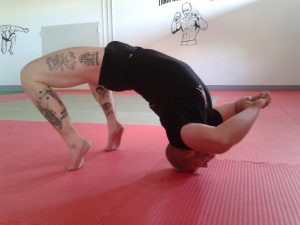
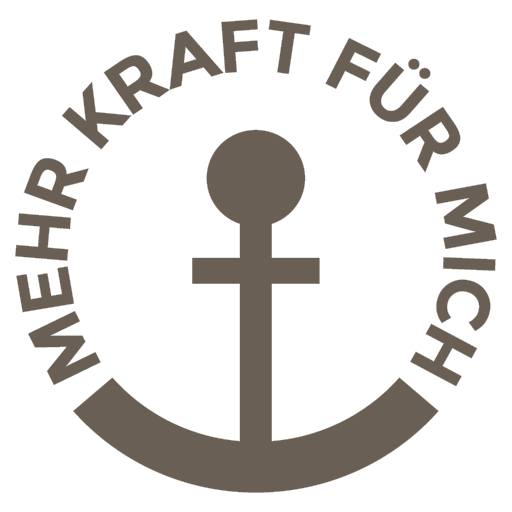
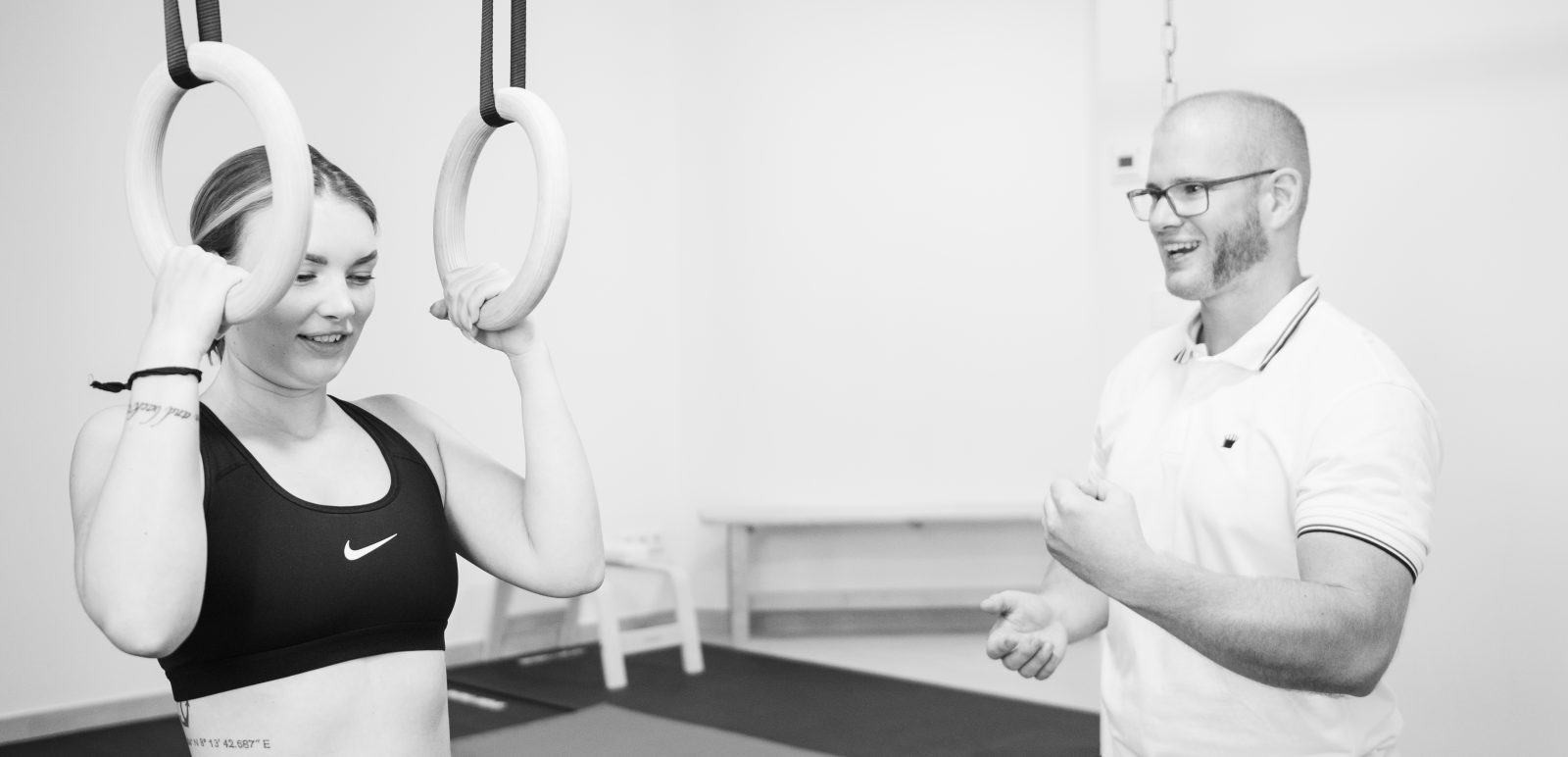
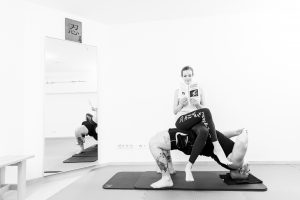
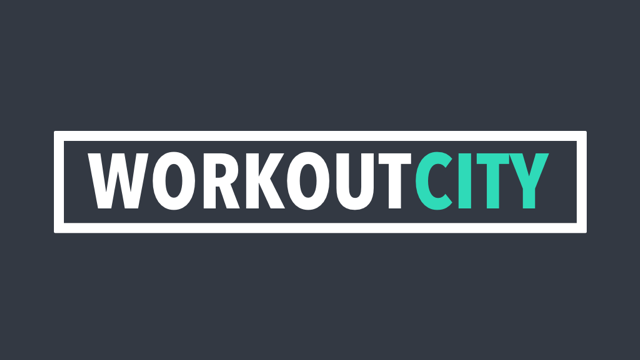
Great article! I have a question, do you also use warm-up before this routine?